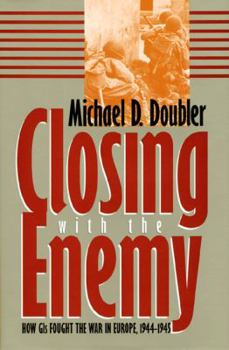Closing with the Enemy: How GIS Fought the War in Europe, 1944-1945
Select Format
Select Condition 
Book Overview
This study picks up where D-Day leaves off. From Normandy through the breakout in France to the German Army's last gasp in the Battle of the Bulge, Michael Doubler deals with the deadly business of war - closing with the enemy, fighting and winning battles, taking and holding territory. His study provides a reassessment of how American GIs accomplished these dangerous and costly tasks.
Format:Hardcover
Language:English
ISBN:0700606750
ISBN13:9780700606757
Release Date:January 1994
Publisher:University Press of Kansas
Length:354 Pages
Weight:1.53 lbs.
Dimensions:1.3" x 6.2" x 9.3"
Customer Reviews
5 ratings
A superior book for military professionals
Published by Thriftbooks.com User , 20 years ago
This book is a superior work and is invaluable to the military professional interested in small unit tactics. COL Doubler has assembled exhaustive detail and provides a masterful analysis of the small unit tactics employed by the German Army and US Army in late WWII. He does so in a manner that is both easy to read and easy to extract: each chapter examines a specific tactical problem or environment. Read the whole thing and use it as a reference later. Military Historians will love it for the detail, but Military Professionals should read this book if they want to see a systematic discussion not only of WHAT the soldiers did, but why they did it that way and how it turned out. If you are an American Soldier add this book to your reading list: much of what you are taught is not tactics, but battle drills. Read this book and see how an earlier generation confronted seemingly insurmountable problems and solved them by thinking for themselves.
Explains as advertised--How the GIs fought
Published by Thriftbooks.com User , 23 years ago
This book fills a real need. Most histories can tell you where and why Bradley, Patton, and so forth did well or ill. Personal memoirs tell about events as one man saw them, but not much about how the guys were trying to act as a team in battle. This book explains how regiments, companies and platoons fought in a variety of conditions, hedgerows, forests, and mountains. It also shows the inititive displayed at all ranks down to private to solve problems. It can only increase your appreciation of "The Greatest Generation" and is a corrective to accounts depreciating the qualities of US infantry.
A must for serious students of WWII
Published by Thriftbooks.com User , 24 years ago
This book is for those who seriously study the subject of World War II. The subject focuses on the tactical rather than the strategic element of the battle. The American soldier was strenuously trained for the Normandy Invasion, but was unprepared for what was to come in the following months of the war. What was in America's favor was an army made up of innovative citizen soldiers with the keen ability to adapt quickly under fire and in the midst of battle with new ways to close with the enemy. Doubler goes to show that the war really belonged to the dogface, the Captains and Lieutenants on the front line. I highly recommend this book.
Essential Coverage of WW II Lessons Learned
Published by Thriftbooks.com User , 25 years ago
This is not a personal WW II story, though it's peppered with specifics on several campaigns. It gives a birds eye view of the practical lessons learned from each of the major battles in the ETO. Often it swoops in to details too. There are excellent explanations of the triangle organization, Division Strategy, Tank / Infantry integration, Airpower/infantry development. There's a good section at the end comparing US, German, and Soviet methods of strategy and learning. Read this before you dive into any other WW II books. It explains what many authors take for granted. Great reading too!
A Great Compliment to Oral Histories of World War II
Published by Thriftbooks.com User , 25 years ago
Doubler deftly explains the sometimes painful learning process of soldiers in war. "Closing With The Enemy" compares pre-War US Army doctrine with practical experience and knowledge learned on the battlefield. Examples of the types of operations outlined in the book include fighting in the Norman bocage, river assaults, and breaching the West Wall (Sigfried Line). This book is a must for anyone wanting to know the "how" behind WWII combat as protrayed in "Saving Private Ryan."





